Section IV: Effective and Maximum Range for 6mm BB's
Section IV-A: Definitions of Effective and Maximum Range
I consider the effective range of an airsoft rifle to be the range at which the BB deviates significantly from the shooter's line of aim. Take the example of a stock Tokyo Marui rifle firing at 0.75 fps with 0.25g BB's. Without hop-up, the BB's would quickly begin accelerating downward, consequently deviating from the shooter's line of aim. A quick estimate from looking at Figure IV-A-01, without hop-up the same rifle would be effective out to about 40 feet. With hop-up properly adjusted for the rifle and same ammunition, the effective range increases to around 100 feet, at which point the BB is roughly 6 inches below the line of aim. (Note that the line of aim is not necessarily a height of 0", nor is it perpendicular to the ground. The reason for this is parallax, which can be better understood by visiting a website that goes into detail about marksmanship.)
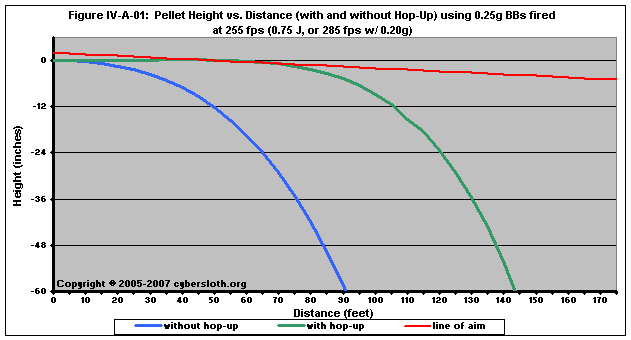
A shooter could sight their rifle in at a different range, thereby increasing the effective range. In Figures IV-A-02, 03, & 04, we can see how this factors in for a sniper rifle firing 0.29g BB's at 415 fps.
In Figure IV-A-02, the rifle has been sighted in at 130'. In the case, the effective range (taken as the range at which the BB is 6" below the line of aim) is about 170'.
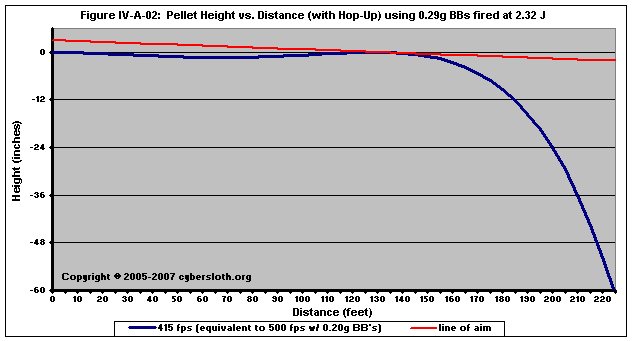
Sighting the rifle to 150' increases the effective range to about 180', as depicted in Figure IV-A-03:
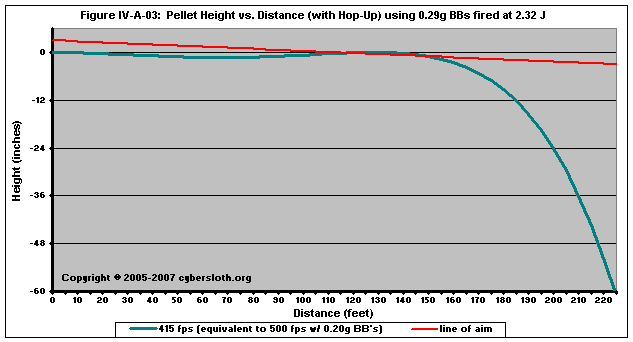
Lastly, sighting the rifle to 170' increases the effective range to about 190', as shown in Figure IV-A-04:

Keep in mind that given the inherent inaccuracy of airsoft, it is very difficult to sight rifles in at long distances. Additionally, it should be obvious that effective range is not strictly governed by muzzle energy nor the weight of the ammunition used. Further, the skills of the shooter come into play in determining the effective range. The effective ranges listed further down are merely rough estimates.
Maximum range was calculated by determining the firing angle that produced the greatest range. While this of no practical use as lobbed shots are in no way accurate, it will give the shooter an idea of how far their BB might travel. Figure IV-A-05 depicts the maximum range of the same 0.29g BB used in the previous example:
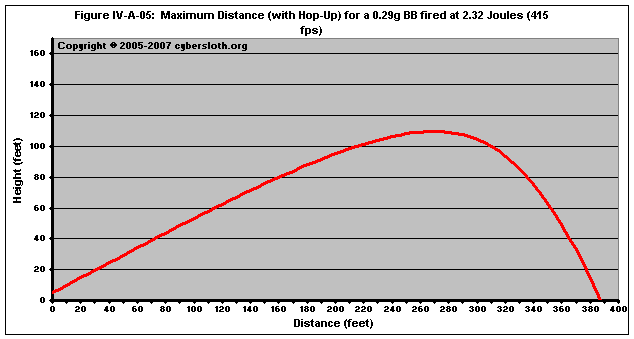
At maximum range, the BB is moving very slowly, often at a velocity near its terminal velocity (which is explained in Section 01-A-02: Density / Volume and Terminal Velocity). At such ranges, the BB will impact with very little kinetic energy, striking with about the same intensity as a small raindrop. In the above example, at a range of 385 feet the 0.29g BB will be moving at roughly 49 fps (or about 0.03 J), not even enough to dent a sheet of paper.
The table below shows shows the firing angle necessary to achieve the maximum range. Note that this is not necessarily 45 degrees. In a vacuum, a firing angle of 45 degrees would provide the greatest range. However, given that the BB falls rapidly during the terminal phase of its trajectory, an angle lower than 45 degrees is necessary to achieve maximum range. Figure IV-A-06 shows how trajectories vary by firing angle for a 0.20g BB fired at 0.75 J. .
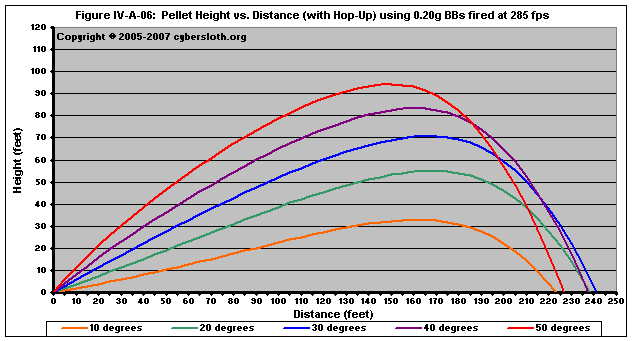
Section IV-B: Effective Range and Recommended BB Weight
Weight is the recommended BB weight necessary to achieve the listed effective range.
Modified Muzzle Velocity is the muzzle velocity achieved with the recommended weight BB at the given muzzle energy.
Effective Range is the range at which the theoretical BB fired from a properly tuned rifle will experience significant deviation from the average trajectory, with a maximum deviation of 6" (explained above). These numbers are not absolute; marksman skills (or lack thereof) will either diminish or extend the range. Further, rifles with exceptional consistency between shots can achieve greater effective ranges, as can a shooter by accounting for holdover. .
Maximum Range is the maximum possible range achievable when using the recommended weight. Keep in mind that a tailwind or higher altitudes / temperatures will allow for a longer ranges.
Maximum Angle is the firing angle that would achieve the maximum range with the listed weight.
MED is the minimum engagement distance for the given velocity and BB weight, allowing for a maximum impact energy of 1.00 J.
|
Muzzle Energy |
Velocity w/ 0.20g BB |
Weight (grams) |
Modified Muzzle Velocity |
Effective Range |
Maximum Range |
Maximum Firing Angle |
MED (feet) |
|
0.37 J |
200 fps |
0.20 |
200 fps |
65 |
215 feet |
26 degrees |
-- |
|
0.47 |
225 |
0.20 |
225 |
75 |
230 |
26 |
-- |
|
0.58 |
250 |
0.20 |
250 |
85 |
240 |
26 |
-- |
|
0.70 |
275 |
0.25 |
246 |
95 |
265 |
26 |
-- |
|
0.84 |
300 |
0.25 |
268 |
105 |
285 |
26 |
-- |
|
0.98 |
325 |
0.25 |
291 |
115 |
305 |
26 |
-- |
|
1.14 |
350 |
0.25 |
313 |
125 |
315 |
25 |
10 |
|
1.31 |
375 |
0.25 |
335 |
135 |
325 |
25 |
15 |
|
1.49 |
400 |
0.25 |
358 |
145 |
335 |
25 |
20 |
|
|
|||||||
|
1.68 |
425 |
0.30 |
347 |
155 |
355 |
25 |
35 |
|
1.88 |
450 |
0.30 |
467 |
160 |
365 |
25 |
40 |
|
2.10 |
475 |
0.30 |
389 |
170 |
380 |
25 |
50 |
|
2.32 |
500 |
0.30 |
408 |
180 |
390 |
25 |
55 |
|
2.56 |
525 |
0.30 |
429 |
185 |
405 |
24 |
60 |
|
2.81 |
550 |
0.30 |
449 |
190 |
405 |
24 |
65 |
|
3.07 |
575 |
0.36 |
429 |
200 |
455 |
22 |
85 |
|
3.35 |
600 |
0.36 |
447 |
210 |
465 |
21 |
95 |
|
3.63 |
625 |
0.36 |
475 |
220 |
475 |
20 |
100 |
|
|
|||||||
|
3.93 |
650 |
0.43 |
443 |
225 |
530 |
20 |
125 |
|
4.24 |
675 |
0.43 |
460 |
230 |
535 |
19 |
135 |
|
4.55 |
700 |
0.43 |
477 |
235 |
545 |
19 |
140 |
|
All calculations were made using a standard altitude of sea level and temp of 68 F / 20 C. |
|||||||
Regarding weight: using the next higher or next lower weight will not significantly alter the effective range. So if you have a 3.35J rifle, you will not see that much of a difference if you are using 0.29g BB's or 0.43g BB's instead of the recommended 0.36g BB's. In fact, most sniper rifles benefit from precision-crafted BB's such as Maruzen SGM's more so than simply increasing the mass of the projectile. Additionally, the lighter 0.29g BB's are safer and require a lesser MED due to greater energy dissipation when compared to the 0.36g and 0.43g BB's.
However, BB weight should be a personal preference rather than simply using what has been listed for posterity's sake. For instance, even though 0.20g BB's are recommended for 200 fps rifles, I still use 0.25g BB's with the AEP I have as they are more consistent for me (and frankly, there is a reason that Tokyo Marui includes 0.25g BB's with their rifles). Ultimately, though, I would still like to stress that these are the calculated recommended weights -- please use what you feel most comfortable using.
Section IV-C: Effective Range Observations
It should be expected that as muzzle energy is increased, effective range increases. However, increasing muzzle energy ultimately succumbs to the law of diminishing returns, meaning that energy increases do not correlate to range increases in a linear fashion. To better explain, consider the effective range gained when going from 200 fps to 300 fps (relative to 0.20g), a gain of some 40 feet (105' - 65'). A linear increase would mean that going from 300 to 400 fps would show another gain of 40 feet effective range, a 400 to 500 fps increase would exhibit yet another gain of 40 feet, so on and so forth. Instead, we see that for every 100 fps gained, we gain less and less effective range. Consider the following chart:
| Initial Muzzle Velocity | Upgraded Muzzle Velocity | Original Range | Upgraded Range | Range Gained | |||
| 200 | 300 | 65 | 105 | 40 | |||
| 300 | 400 | 105 | 145 | 40 | |||
| 400 | 500 | 145 | 180 | 35 | |||
| 500 | 600 | 180 | 210 | 30 | |||
| 600 | 700 | 210 | 235 | 25 |
As is shown, a increase of 100 fps will garner an extra 40' of range up to about 400 fps, and thereafter the gains come in smaller increments. Even so, the decrease in gained range is much less than it would have been if a constant BB weight were used. By increasing the weight of the projectile, the gained range in going from 600 fps to 700 fps is still 25 feet, not too far reduced from the 40 feet gains observed when upgrading from lesser velocities. If 0.20g BB's were the only available weight, the above chart would look more like this:
| Initial Muzzle Velocity | Upgraded Muzzle Velocity | Original Range | Upgraded Range | Range Gained | |||
| 200 | 300 | 65 | 105 | 40 | |||
| 300 | 400 | 105 | 140 | 35 | |||
| 400 | 500 | 140 | 170 | 30 | |||
| 500 | 600 | 170 | 195 | 25 | |||
| 600 | 700 | 195 | 210 | 15 |
The above chart demonstrates the diminished returns much more clearly. Of course, the chart is somewhat misleading as 0.20g BB's exhibit atypical behavior at velocities above 500 fps due to peculiarities of Magnus Lift. As of such, it would be impossible to achieve the ranges listed because the 0.20g BB's would not provide any degree of long-range accuracy with high-energy rifles.
As an aside, this trajectory project suggests that both the size and weight of airsoft projectiles are optimal for hop-up. Many shooters -- particularly snipers -- wonder why SGM's only weigh in at 0.29g. Based on the data presented in this study, BB's in the range of 0.28g to 0.30g seem to offer good trajectory characteristics while ensuring safety due to the lesser weight used. For instance, the difference in range of a 0.30g BB and a 0.43g BB at 3.93 J is negligible when considering the 6" envelope used to determine effective range. Granted, a shooter using holdover to snipe more distant targets may see an extra 20 feet of effective range at such a high muzzle energy, but for most practical sniper rifles, 0.43g BB's (even if they were precision crafted) appear to offer no significant advantage over the lighter 0.29g BB's. Given the higher costs associated with producing heavier BB's, and the already high cost of precision crafted BB's, 0.29g BB's seem to be a good compromise.
Additionally, one last point I'd like to stress is that the correlation between effective range and muzzle energy is not absolute. It is far better to have a rifle that is able to achieve greater consistency between shots rather than a rifle that is very powerful, as the former will often provide greater effective range.